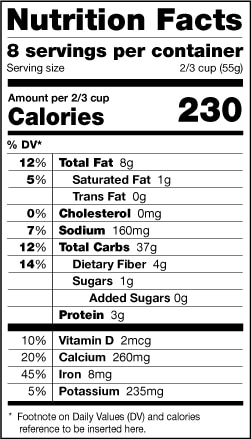Recently the FDA unveiled a proposed update to the 20-year-old nutrition facts labeling requirements. Is this a good thing? It depends on whom you ask. Manufacturers will have to update all their packaging to meet the new standards within 2 years. (Currently, there is a 90-day public commentary period before the proposed changes are confirmed.) Consumers will benefit from a clearer hierarchy of data and information that better informs them about what they’re eating. All in all, it’s a good step forward for Americans.
EDIT: As of July 13, 2017, the FDA has announced that they will extend the compliance deadline. They will release more information on the specific new dates soon and we will update here.
For more FDA labeling requirements, see our FDA Food Labeling Guide made Easy.

Servings per container are the next largest in the hierarchy and will have to be an accurate reflection of the amount consumed. It’s misleading when a drink or snack bar package contains two servings per container but the nutrition facts are for half that. The new regulations would change that.
Percent Daily Values would come before the amount listings as it’s more important for people to understand how what they’re eating factors into the total of what is recommended to eat in a day. The closer proximity of the percentages to its name (e.g., Total Fat) makes it easier to read instead of your eye having to follow the line across the table.
Added sugars is a new listing on the label, differentiating natural sugars (such as sugars in fruit) from those added during the process. This will be a great benefit to brands that are currently calling out elsewhere on their packaging that their sugars are natural and not processed as it will make it clearer in the data itself.
Calories from fat would be eliminated on the new label. The reasoning for this is to put emphasis on the type of fat rather than the total amount of fat one is consuming, as not all fats are bad and good fats are necessary.
Nutrient listings would be updated in the same format with percent daily values listed to the left, and their amounts would need to be listed as well (currently, just percentages are listed). Additionally, Potassium and Vitamin D would be required listings as many people are not getting enough of these nutrients.
There are no changes for manufacturers to make yet as it is still during the 90-day comment period. Furthermore, the FDA has not yet released any updated alternate Nutrition Facts formats such as the tabular or linear formats.
For more information and to weigh in during the 90-day comment period, see the FDA article on the proposed changes.





